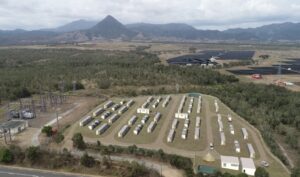South Australia and Victoria seem to be engaged in a competition for bragging rights over who has the biggest big battery in the country.
Right now it is South Australia, with the newly expanded Hornsdale Power Reserve (150MW/194MWh), but the mantle late next year will go to Victoria, where Hornsdale owner Neoen has committed to building a 300MW/450MWh big battery at Geelong, before the crown possibly returns to South Australia with AGL’s proposed “gigawatt hour” battery next to the Torrens Island gas generator.
What we can be sure of is that big batteries will get even bigger. AGL has talked of a 500MW battery at Liddell with as yet unspecified hours of storage, Neoen is talking of a 900MW/1800MWh big battery at the massive Goyder South wind and solar hybrid plant in South Australia, while Sun Cable may trump them all with a 20 gigawatt hour battery in the Northern Territory if its bold plan to supply Singapore with the world’s biggest solar farm becomes a reality.
Big might be beautiful, and able to steal the headlines, but the real significance of the most recent announcements – Neoen’s in Victoria and AGL’s in South Australia, as well as this week’s new AGL big battery proposal for the Loy Yang A brown coal generator in Victoria – is not just their size, but what they are able to do.
Batteries are often dismissed – including, regrettably, by prime minister Scott Morrison and others who should know better – as being next to useless because they say they can only power a state or a smelter for a matter of minutes or seconds. See: On first day as PM, Morrison learns difference between Big Battery and Big Banana.
Those comments show a complete misunderstanding of what batteries are supposed to do, and they have already been rubbished by the performance of any number of big batteries already installed across the country – whether it’s the ability to keep the lights on in a local region when the grid elsewhere fails, protecting South Australia from major faults and transmission losses, or slashing the cost of gas back-up and improving reliability to the mines owned by Australia’s richest people in the Pilbara.
Batteries have become specialists at providing critical grid services such as frequency control, and are now moving into the large scale provision of “synthetic inertia”. Soon they will be “grid forming”, rather than “grid following”, and offering “system strength”, but these are just a fraction of the so-called “value stack” that is on offer. All of these eat into the domain traditionally dominated by the fossil fuel generators.
But wait, there’s more. The Victorian big battery is significant because its primary service will be a contract with the Australian Energy Market Operator in its System Integrity Protection Scheme (SIPS). What it means in practice is that AEMO will be able to operate the main transmission link between NSW and Victoria at near capacity, over the crucial summer period where the contract applies, allowing more to be imported into Victoria, particularly at times of peak demand.
Currently, most transmission links are restricted in the amount of capacity they can transfer, because AEMO needs to keep some in reserve in case of an outage or a fault. The Victorian big battery will provide 250MW of “virtual transmission” capacity that can be injected when required.
It only has half an hour of storage under that contract because that is all that is needed to give AEMO the breathing space to marshall its resources if a fault does emerge.
So the real value of the battery is far greater than a 30-minute extension. It effectively means it can provide an increase in the transfer capacity for any length of time. In short, it provides the same capacity as a 250MW gas generator for lengthy periods, but without the fuel cost and with greater flexibility.
Neoen has already been providing this SIPS service at Hornsdale to AEMO for the South Australia grid, but that service has been provided “free of charge”. The difference with Victoria is that Neoen will be paid $12.5 million a year for the SIPS service, and the battery will be free to earn money elsewhere and through other services with the rest of the capacity.
During summer that means 50MW and a whopping 325MWh to play in the arbitrage market, and for the rest of the time the full 300MW and 450MWh buying cheap wind and solar. It could make quite an impact on the Victoria market.
 The Victoria government’s business case study makes clear the benefits – crucially, a much reduced chance of “unserved energy” (rolling blackouts – and avoiding the reputational damage of such events) and a strengthening of the grid, and a big reduction in electricity prices. And the benefits easily outweigh the costs.
The Victoria government’s business case study makes clear the benefits – crucially, a much reduced chance of “unserved energy” (rolling blackouts – and avoiding the reputational damage of such events) and a strengthening of the grid, and a big reduction in electricity prices. And the benefits easily outweigh the costs.
The two batteries proposed by AGL in South Australia (250MW/1,000MWh) and Victoria (200MW/800MWh) are equally significant. Firstly, they will be located next to big fossil fuel generators, which they will ultimately help displace.
And, for the first time in Australia, they will have up to four hours of storage, meaning that they will compete directly with traditional gas plants, particularly peaking plants, to provide cover for the few hours a day of peak demand, and particularly in the early evening when rooftop and utility scale solar wind down.
Four hour storage has become common in the US, where the combination of solar and batteries has easily won out in tenders over competing bids from gas generators as utilities and regulators prepare for peak demand periods.
It means that gas plants will be increasingly forced out of the market in terms of bulk storage by cheaper wind and solar, and their role as “firming” generators will be marginalised by the prevalence of big batteries, particularly over shorter time periods. The emergence of longer duration pumped hydro storage will further reduce their market opportunity.
AGL has told RenewEconomy that it is likely it will initially build its 250MW South Australia big battery – to be located at the site of its ageing Torrens Island gas plant – with one hour of storage, and then expand the storage duration as the market opportunity emerges (and presumably as the use of traditional gas generators winds down). A similar staged strategy will be adopted at the Victoria battery next to the Loy Yang A coal fired power station.
What these battery developments tell us is that this technology is multi-faceted, and as costs continue to fall, and their value recognised by the market – firstly by the shift to 5-minute settlements and then by the creation of new markets for a multitude of grid services – then their deployment will multiply in size and numbers.
South Australia will be the proof of the pudding. It is already running at 58 per cent wind and solar (over the last 12 months), and this share will be increased significantly once the installation of synchronous condensers over the next 12 months allows more gas generators to be dialled down, constraints on wind and solar to be relaxed, and fewer “directions” in the market.
And as the number of wind and solar projects continues to grow, along with battery storage – at Goyder South, Torrens Island, Lincoln Gap and Playford, and possibly Snowtown and Morgan, amongst others, then the focus will turn to longer duration storage, and the handful of pumped hydro projects that are competing for space in the South Australia grid. That will come close to signalling the end of the road for fossil fuels in South Australia’s grid, and it’s just a matter of time before that occurs elsewhere in the country too.
Note: This story updated to reflect fact that Victoria big battery contract is for the summer months only.








